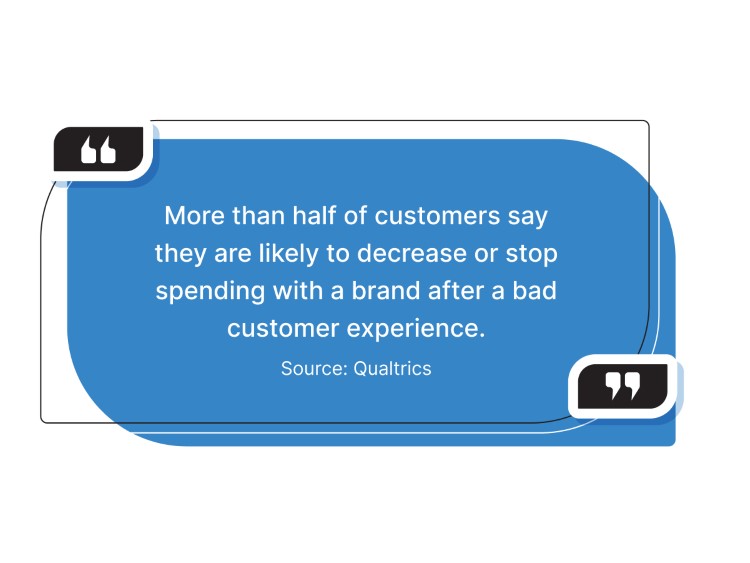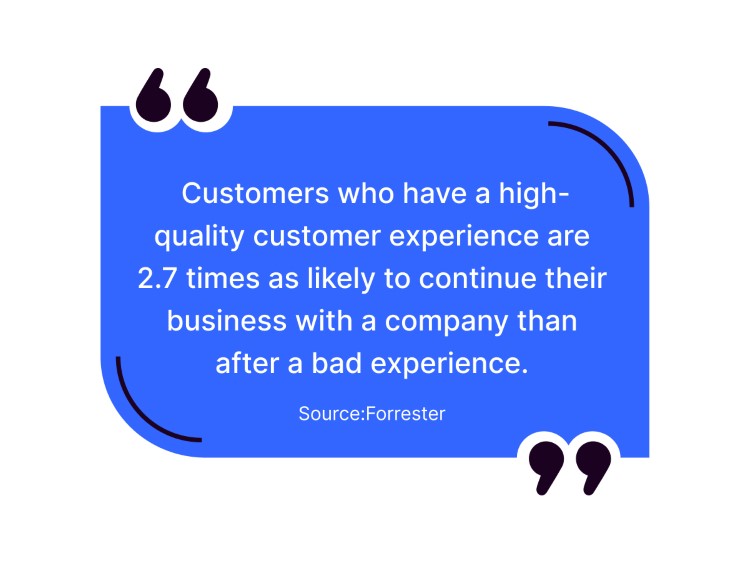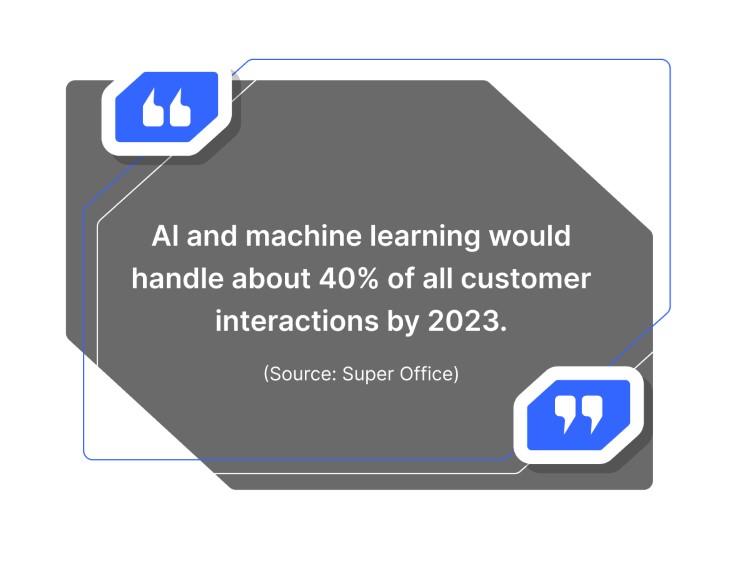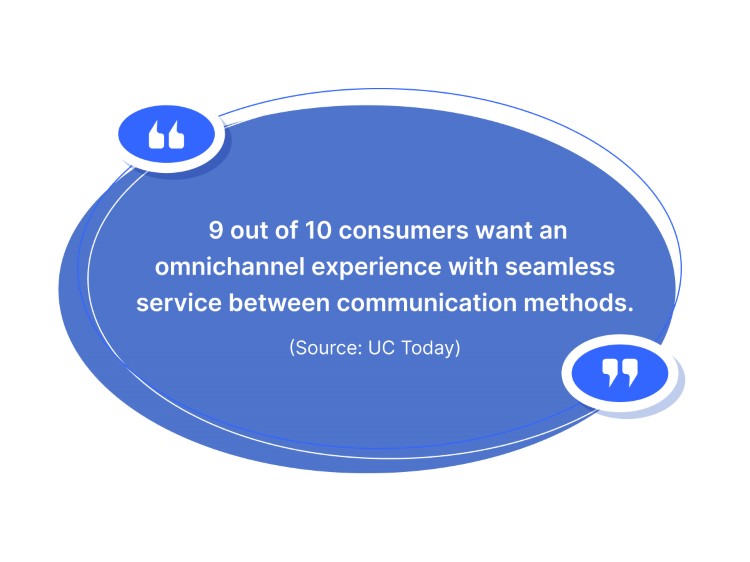The quality of customer experience can set you apart from competitors significantly. According to the PwC Future of Customer Experience Survey, participants expressed a willingness to pay up to 16% more for a positive customer experience. Conversely, negative experiences leave a lasting mark; in the same survey, 32% indicated that a single bad experience could lead them to discontinue their loyalty to a beloved brand. Ouch, indeed! Considering the utmost importance of customer experience, how can you ensure its excellence? The answer lies in utilizing customer experience tools that enable you to enhance every interaction between your brand and customers, ultimately guaranteeing a consistently positive or near-positive experience!
These tools can furnish you with insights into your customers’ website interactions, their brand sentiments, and offer guidance on enhancing and optimizing their overall experience and interactions.
Here, we’ve compiled a selection of top-notch customer experience tools. Let’s explore how you can implement these in your business.
The Heart of CX: Understanding Customer Experience
In straightforward terms, Customer experience (CX) represents how your customers view your brand.
What exactly do your customers think about their interactions with your brand when they utilize your company’s products or services? Customer experience encapsulates precisely this. Covering the complete scope of a customer’s engagement with a company, CX includes every single point of contact – from physical in-store experiences to online shopping, website navigation, and engagements with customer support teams.
In the current era, customer experience holds paramount importance. Brands that establish a successful customer-centric approach position themselves for financial prosperity. In fact, a significantly large number of consumers are willing to pay a premium for an exceptional customer experience. Conversely, one out of every three customers has indicated that they would part ways with a beloved brand if they encountered a single negative experience.
Businesses are increasingly recognizing the significance of customer experience and are allocating greater resources to enhance their CX operations. Approximately 45.9% of brands have identified customer experience as a primary focus for their business in the coming five years. The reason for the growing emphasis on customer experience becomes evident. This is where Customer Experience Management systems play a crucial role—enabling the monitoring, measurement, and enhancement of CX.
What is a Customer Experience Tool?
A Customer Experience (CX) Tool refers to software or platform crafted to assess, analyze, and improve customer interactions and satisfaction with a business’s products, services, or brand. These tools are like wizards with features such as surveys, feedback forms, and analytics that help businesses understand how customers feel and how to make their experience even better.
Customer Experience Management: Building Loyalty and Growth
Customer Experience Management, often referred to as CEM, serves as a framework that companies employ to monitor, oversee, and address all interactions between customers and the business. Numerous companies aspire to enhance their customers’ experiences, and this journey begins with establishing a baseline. An effective CEM system fundamentally empowers companies to elevate customer satisfaction, foster loyalty, and promote advocacy.
Key aspects of Customer Experience Management include:
- Understanding Customer Needs
- Mapping Customer Journeys
- Setting Customer-Centric Goals
- Collecting and Analyzing Data
- Implementing Improvements
- Employee Training and Engagement
- Omnichannel Approach
- Feedback and Continuous Improvement
- Crisis Management
Exploring the Role of Customer Experience Tools
The customer experience management tools examine all customer interactions, extracting valuable insights that can be acted upon to boost customer loyalty and elevate the overall customer experience.
Delivering an unforgettable customer experience goes beyond simply addressing customers by their names or recalling their food preferences. There is an opportunity to explore more deeply.
Thankfully, we possess the capability to leverage data and an abundance of analytical tools to monitor essential aspects of the customer journey. This is where the role of customer experience tools becomes evident. In the current competitive business environment, marked by shifting customer expectations and preferences, these tools enable businesses to maintain a proactive stance.
Maximizing Impact: How to Choose Your CX Software Wisely
Is your aim to implement it for the purpose of assessing and enhancing the performance of your customer service team? Or, are you looking to uncover specific aspects linked to customer satisfaction?
Additional factors to take into account involve the types of surveys or questions you intend to deploy and whether the software offers comprehensive analytics and reporting capabilities. Are its essential features like feedback management, predictive analytics, and customer self-service user-friendly and readily accessible? Let’s go through the basic 5 considerations for choosing a CX software.
1. Omni-Channel
Modern customer journeys are intricate, multifaceted, and encompass various channels. A customer might initiate an interaction with your company through a self-service bot or mobile app and later transition to a conversation with a live agent via phone.
It’s essential to ensure that your CX solution enables communication with customers via their preferred channels. Equally important is the seamless backend integration of these channels to enable tracking of conversation context and details as they transition from one environment to another.
An overwhelming 96% of consumers anticipate that companies will facilitate effortless transitions between channels. Therefore, if you’re offering customers the choice between text, video, and phone communication, it’s imperative that these options are seamlessly interconnected. On the subject of integrated solutions, strive to ensure that your customer experience platform simplifies the process of transitioning from a self-service environment to engaging with an agent. The appropriate tools should automatically transmit contextual information to your agents when they take a phone call or respond to a chat message.
2. Self-Service
Customers are exhibiting growing self-reliance. Nowadays, they prefer to independently seek solutions to their problems rather than reaching out to a customer service agent. In fact, 68% of customers express a preference for utilizing self-service channels when dealing with straightforward queries.
It is essential to discover CX software that empowers you to assist customers effectively during their self-service journey, aligning with the requirements of today’s digital customers. Nonetheless, it’s vital to expand your thinking beyond the basic FAQ-style bot. With customers facing increasingly intricate challenges, they are turning to bots for assistance with a broader spectrum of issues.
Incorporating AI tools that possess genuine conversational intelligence, natural language processing capabilities, and automated algorithms will enable you to provide an advanced self-service experience, setting you apart from competitors.
Furthermore, this can lead to a decrease in the number of challenging calls your agents have to handle. The more intelligent your self-service options become, the more they relieve the burden on your staff. Additionally, they can gather valuable insights into customer behavior and emerging trends.
3. Automation of Business Operations
Automation is swiftly evolving into an essential component of the CX landscape, particularly as labor shortages and the challenges of the Great Resignation make it challenging to recruit skilled professionals for any team. Furthermore, automation is not intended to supplant your staff; instead, it streamlines and eliminates repetitive tasks that would otherwise consume a significant portion of your staff’s time. This, in turn, allows your team to concentrate on tasks of greater significance.
A CX solution that incorporates inherent workflow automation features enables you to craft efficient workflows for various purposes, whether it involves inputting customer data into a CRM or structuring your team’s timetable. Automation can guide your customers to the most suitable personnel consistently by utilizing intelligent insights and triggers, simultaneously boosting your employees’ productivity.
4. Seamless Integration and Customization
A CX platform usually serves as a key element within a comprehensive customer experience and service strategy for any company. To guarantee that your team members can collaborate effortlessly within a unified interface, it’s essential to ensure that your CX platform can be seamlessly integrated with the tools they are already accustomed to, including collaboration applications, help desk systems, and CRM software.
An adaptable platform that can align with your team’s technological requirements provides the flexibility to incorporate new features through connected applications as necessary. In your quest for integration possibilities, it’s equally important to assess the ease of configuration and management of your CX software. You shouldn’t be required to enlist a developer’s assistance every time you wish to implement a change.
5. Reporting & Analytics
In today’s dynamic world, it’s crucial to remember that customer expectations are continually shifting and progressing. To maintain a competitive edge and stay ahead of your rivals, it’s imperative to collect comprehensive information about your target audience, your team, and other important metrics that pertain to your business.
An effective CX platform should provide you with valuable insights into every stage of the customer journey, pinpointing areas of friction and suggesting enhancements for improved satisfaction. Simultaneously, it should enable you to stay attuned to your employees’ experiences, regardless of their geographic locations. By monitoring and addressing employee concerns, you can guarantee that your team members can operate at their optimal performance levels.
Customer Experience Tool Types
Customer Experience (CX) tools come in various types, each serving specific aspects of the customer journey and interaction. Here are some common types of customer experience tools:
- Tools for Customer Support: These tools give businesses the superpower to handle and solve customer problems smoothly, whether it’s through live chat, email, or social media.
- Customer Relationship Management (CRM) Systems: Such CX tools help to manage interactions, store customer information, and track communication history to provide a comprehensive view of each customer.
- Engines for Personalization and Recommendations: These magic tools use data and smart algorithms to create special content, offers, and experiences just for you, making sure you have an awesome time!
- Customer Analytics and Reporting Tools: With such CX software, you can analyze customer data, behaviors, and feedback to derive actionable insights, helping you make informed decisions.
- Survey and Feedback Tools: Here you can collect customer opinions and feedback through surveys to understand their satisfaction levels and gather insights for improvement.
- User Onboarding Software: These CX management tools are like friendly guides, helping users smoothly get the hang of a product or service as they start using it.
Leading the Way: Top 10 Must-Have Customer Experience Tools of 2024
1. REVE Chat
REVE Chat is one of the best customer experience management platforms designed to enable you to provide excellent customer service across various channels, including the web, mobile apps, and popular social media platforms such as Facebook, Viber, Instagram, Telegram, and WhatsApp. With REVE Chat, your customer agents can deliver immediate online support to your customers 24/7.
Key Features:
- Chatbot: The AI-powered bot is available to help you automate various business operations, including customer interactions. Similar to human agents, it can assist customers, allowing your agents to focus on more complex tasks.
- Ticketing: The ticketing tool enables you to prioritize customer requests and monitor their progress throughout the support process. It seamlessly combines live chat with ticketing, streamlining the resolution of customer issues. This provides you with a comprehensive view that encompasses chat history, ticket history, and valuable customer information, all conveniently accessible through a unified platform.
- Live Chat: Enable your customers to start live chat sessions and engage with your support team for immediate assistance.
- Video Chat: The video chat functionality empowers customers to commence video calls with your customer support agents directly within the chat interface.
- Co-Browsing: Additionally, with the Co-Browsing feature, you can observe and manage your customer’s screen in real time during a live chat session. This capability enables you to offer technical support, aid in online purchases, or provide demonstrations of products or services.
- CX Analytics Tools: REVE Chat provides essential reporting and analytics tools that offer insights into the customer experience. This includes details such as contact information, geographic locations, page views, chat history, and more. These features help you gain a deeper understanding of how customers discover and engage with your products or services.
You can explore all of REVE Chat’s distinctive features with a complimentary 14-day FREE TRIAL. Don’t hesitate to SIGN UP today to experience it firsthand!
2. Salesforce
Salesforce Service is renowned as a top-tier customer experience platform solution that empowers users to streamline service processes and oversee all service-related activities through a unified platform.
This AI-driven software platform facilitates business growth and scalability by engaging customers across various channels and also provides robust tools for payment and transaction management.
Key Features:
- Customization: It offers a range of customizations and features that aid in creating an exceptional customer experience and delivering faster, more efficient, and superior service.
- Contact Management: Salesforce, effortlessly handles and arranges your contacts, ensuring that you have a comprehensive understanding of every customer listed in your contacts through effective contact management.
- Lead Management: You can boost your leads and sales potential by efficiently matching leads with the most suitable customers, thanks to lead management.
- Automation: Leverage automation to enhance your business and generate more sales, while also simplifying the process of acquiring clicks and leads.
3. Netomi
Netomi is one of the best AI enabled CX management tools for customer service, empowering businesses to activate, oversee, and train AI systems to autonomously address support tickets. This, in turn, boosts agent efficiency and ensures the delivery of a top-tier customer experience. Netomi’s AI chatbot plays a vital role in augmenting and assisting customer service teams in providing top-tier support.
Key Features:
- Omni-Channel: As a versatile chatbot it extends its support capabilities across various channels, including web chat, social media messaging platforms, SMS, and voice, in order to provide customers with the convenient, effortless, and personalized support they expect, regardless of time or location.
- Integration: It seamlessly integrates with popular web chat platforms enabling teams to automate repetitive customer inquiries and deliver highly relevant articles from the company’s knowledge base.
- Reporting & Analytics: Additionally, it offers real-time analytics and reporting, providing actionable insights and identifying areas for optimization.
4. Zendesk Sunshine
Positioned as “customer service champions,” with a compelling blend of extensive customer service proficiency and in-depth product knowledge, the Zendesk customer experience platform empowers businesses to provide a unique and distinctive CX. Serving as the “bedrock of Zendesk,” Sunshine is an open and adaptable platform, constructed natively on AWS.
Key Features:
- Integration: This cx management software seamlessly integrates with Zendesk’s other customer service tools and provides access to hundreds of third-party apps via the Zendesk marketplace.
- Analytics: Zendesk Sunshine furnishes agents with a unified customer view, allowing teams to establish connections and gain a comprehensive understanding of all customer data, consolidating information from various sources such as order history, loyalty status, and web activity.
- 360-Degree Customer View: Sunshine offers a consolidated perspective of customer data, bringing together information from diverse sources. This empowers support agents and other teams to gain a thorough and holistic understanding of individual customers.
- Omnichannel Support: It enables engagement through various communication channels like email, chat, social media, and phone, permitting customers to connect with your business via their chosen method of communication.
5. Sprinklr
The unified customer experience management platform by Sprinklr, known as Unified-CXM, harnesses cutting-edge AI to formulate data-driven strategies and elevate customer interactions. By consolidating communications from over 30 digital channels into a single unified platform, customer service agents are more proficient in addressing cases and can craft a seamless experience for customers.
Key Features:
- AI-Powered Solution: Utilizing AI-driven social listening, the system identifies critical cases by analyzing millions of daily conversations and then automatically directs them to the appropriate agents, enabling proactive responses.
- Message Sorting: AI-driven message sorting categorizes messages as either engageable or non-engageable, enabling customer service teams to concentrate their efforts on conversations that demand a human touch.
- Enhanced Agent Performance: The AI Agent Assist feature surfaces pertinent cases and knowledge articles, provides intelligent responses, and highlights a customer’s previous satisfaction ratings, assisting agents in delivering timely and appropriate responses.
6. Adobe Experience Manager
By merging digital asset management with the capabilities of a content management system, Adobe Experience Manager empowers businesses to produce, oversee, distribute, and refine personalized content for their customers. The tool’s AI features expedite content creation, allowing teams to swiftly expand their reach across various channels.
Key Features:
- Analytics: It offers content insights that furnish performance data for each newly generated webpage by utilizing web analytics and SEO recommendations, thereby empowering businesses to enhance their content-related decision-making.
- AI and Machine Learning: Utilizing AI and machine learning functionalities you can leverage consolidated customer profiles to provide customized experiences.
- Reusable Web Designs: You can utilize its web design to make content more efficient and reusable across different devices, resulting in a unified web experience across multiple platforms.
- Integration: With native connectivity seamlessly integrated across Adobe Creative Cloud applications and services, you and your team can easily connect, create, and collaborate without the need to switch from your current applications.
7. HubSpot
HubSpot Service Hub represents customer experience management software designed for customer onboarding, efficient customer support delivery, and the nurturing of customer relationships. It facilitates a streamlined and comprehensive service approach that excels in delivering customer satisfaction on a large scale.
Key Features:
- Customer Feedback Software: This tool empowers you to dispatch tailored surveys such as NPS, customer effort score (CES), and customer satisfaction (CSAT) to your customers. This enables you to assess loyalty and measure the ease with which customers access support at various stages of the buyer’s journey.
- Centralized Interface: This CX tool not only aids in supervising the customer experience but also effortlessly harmonizes with your CRM platform, guaranteeing that your entire customer data repository is centrally situated, consistently kept up-to-date, and easily accessible.
- Live Chat and Chatbots: HubSpot equips you with live chat and chatbot functionalities to deliver real-time customer support and engagement directly on your website.
- Analytics and Insights: The platform delivers comprehensive analytics and reporting tools designed to gauge the impact of your marketing campaigns, monitor website traffic, and assess customer engagement.
- Streamlined Sales Processes: You have the capability to automate sales workflows, monitor deal progress, and efficiently manage your sales pipeline to enhance the experience for prospective customers.
8. Clarabridge
Clarabridge, a frontrunner in omnichannel conversational analytics, employs AI-driven speech and text analysis coupled with Natural Language Understanding (NLU) to assess the dialogues taking place between customers and employees on a daily basis. These interactions encompass phone calls, live chats, private messages, and social media exchanges.
Key Features:
- AI-Powered Solution: Leveraging AI-powered Natural Language Understanding (NLU), it meticulously analyzes extensive feedback and conversations, unveiling a diverse set of insights encompassing topics, effort perception, emotions, sentiment, and intent. By employing machine learning methodologies, it assesses a repertoire of over 50 distinct emotions.
- Analytics: Clarabridge Studio also offers customer experience analytics tools for consolidating all experience data and conducting comprehensive analysis in a single location. It also includes highly adaptable reporting dashboards, intelligent search features, and automated alert systems.
- Voice of the Customer (VoC) Programs: It supports the design and execution of VoC programs, helping businesses collect, analyze, and act upon customer feedback to foster improvements.
- Benchmarking: Here companies have the ability to assess their CX performance in relation to industry standards and competitors, acquiring valuable insights into their competitive standing.
- Root Cause Analysis: Clarabridge assists in pinpointing the underlying themes and trends in feedback data, allowing businesses to discern the root causes of customer issues and complaints. This, in turn, empowers businesses to implement precise measures to resolve customer pain points effectively.
9. Hotjar
Hotjar functions as a website heatmap and behavioral CX platform, providing the means to comprehend your website visitors’ interactions. By gathering user feedback and converting it into actionable insights, you can pinpoint the most effective strategies for enhancing website visitor conversions.
Key Features:
- Heatmaps: Display user behavior graphically and pinpoint opportunities for enhancing user experience.
- Recordings: Capture sessions to create a comprehensive user journey map, recognize behavioral patterns, and identify obstacles. Detects and addresses bugs through console tracking.
- Surveys: Distribute on-site and external surveys to gather real-time product feedback from users. Utilize over 30 survey templates to gain customer insights on factors like churn, loyalty, product satisfaction, content quality, and more.
- Feedback Widget: Present an engaging feedback widget to gain deeper insights into the user experience. Users have the option to highlight elements on the page or within the app that elicit either satisfaction or frustration.
- Funnels: Understand the precise locations and reasons for user drop-offs, visualize conversion pathways and uncover the actual behavior at crucial customer touchpoints.
10. Survicat
Survicate is a customer feedback and survey application designed to assist you in gathering customer input, conducting specific surveys (such as those for websites and apps), and distributing surveys across various channels like email and chat.
Survicate’s key services include marketing insights that enable a deeper understanding of prospects and customers, product feedback to identify areas for product improvement, and customer satisfaction data for insights into factors like lifetime value and retention.
Key Features:
- Survey Generation: Survicate provides a user-friendly platform for creating a range of survey types, including NPS (Net Promoter Score), customer satisfaction (CSAT), and custom surveys customized to address specific business needs.
- Feedback Widgets: With Survicate, you have the capability to integrate feedback widgets seamlessly into your website or within your web or mobile app. These widgets enable the direct collection of user feedback and insights as they engage with your digital assets.
- Email Surveys: It enables you to employ email surveys for gathering feedback from your customers. This can be achieved through email campaigns and automated processes.
- Website Surveys: Survicate’s features empower you to construct on-site surveys that pinpoint particular pages or events, capturing real-time feedback from users as they navigate your website.
- Integration: Survicate commonly connects with a variety of customer relationship management (CRM), and analytics tools, streamlining the process of consolidating and analyzing feedback data within your established workflows.
Finding the Right Fit: Customer Experience Tools Selection
Since your business requirements are distinctive to your team and industry, opt for the solution that integrates most harmoniously with your organization, and one that can deliver enduring results.
While these customer experience measurement tools offer significant capabilities on their own, their true potential is fully realized when paired with a robust AI-powered chatbot like REVE Chatbot. These chatbots can autonomously resolve more than 80% of routine queries, enabling agents to concentrate on tasks demanding a distinctly human touch. The outcome? Elevated customer satisfaction and support spanning multiple channels, including websites, mobile apps, email, chat, and other social media platforms.








